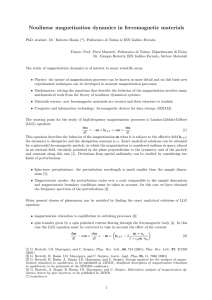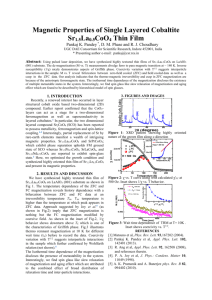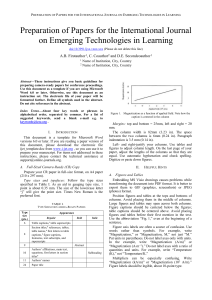SM revised - AIP FTP Server
advertisement
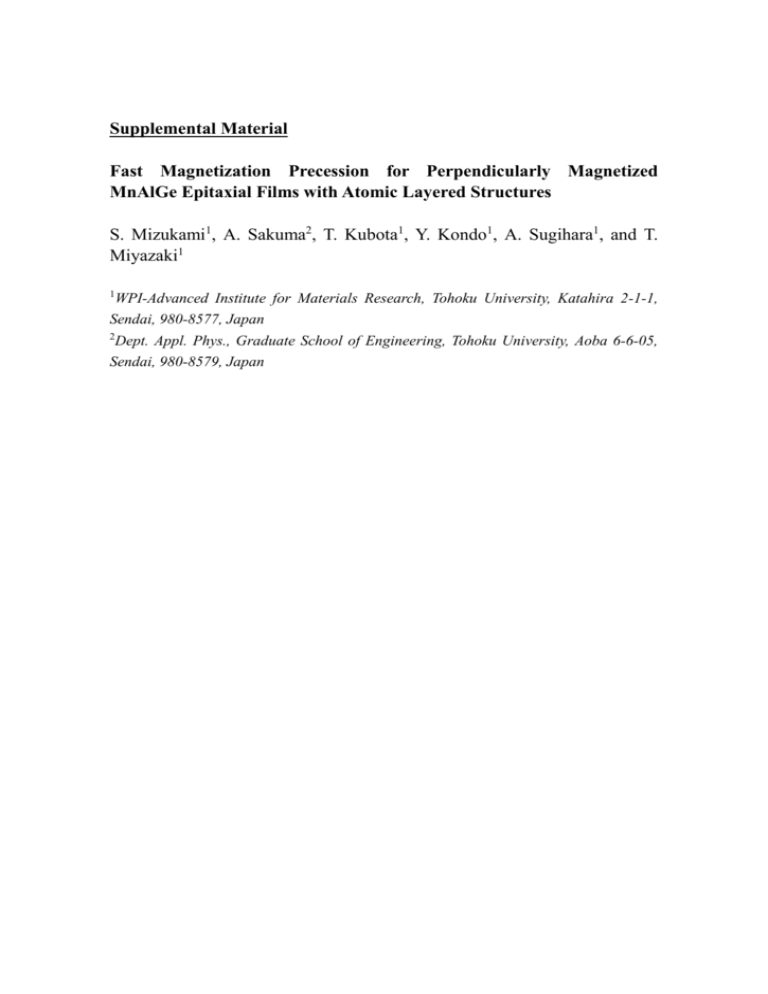
Supplemental Material Fast Magnetization Precession for Perpendicularly Magnetized MnAlGe Epitaxial Films with Atomic Layered Structures S. Mizukami1, A. Sakuma2, T. Kubota1, Y. Kondo1, A. Sugihara1, and T. Miyazaki1 1 WPI-Advanced Institute for Materials Research, Tohoku University, Katahira 2-1-1, Sendai, 980-8577, Japan 2 Dept. Appl. Phys., Graduate School of Engineering, Tohoku University, Aoba 6-6-05, Sendai, 980-8579, Japan 1. Analysis method Three temperature model had been proposed in the past [1]. Recently the modified three temperature model (M3TM) [2] and also atomistic Landau-Lifshitz-Bloch (LLB) model [3] were suggested to describe the laser-induced magnetization dynamics. The M3TM is proven to be identical partially to LLB [3]. So, here we use M3TM for simplicity. In this model, the time-dependence of the electron temperature Te, the phonon temperature Tp, the magnetization normalized by that at T=0 m, and the magnetization unit vector m are expressed by the following set of equations: Ce Te Ce T p t Te T e g ep T p Te , t z z g ep Te T p , T dm Rm p dt TC TC 1 m coth m Te (S1) (S2) , m 2 A m m . m Hu H keff m z z m t M z t (S3) (S4) The temperatures and magnetization are assumed to depend only on the depth z from the surface. Eq. (S1) is the heat diffusion equation for electron and Ce, gep, and are the electron specific heat, electron-phonon coupling constant, and thermal conductivity of electron, respectively. Ce is also a function of Te, which is expressed as CeeTe. Eq. (S2) is the heat diffusion equation for phonon without the heat diffusion term and Cp is the lattice specific heat. Eq. (S3) is the equation describing the magnitude of magnetization with different electron and phonon temperature varying with time. The constant R characterizes the speed of magnetization change with time and TC is the Curie temperature. Eq. (S4) is Landau-Lifshitz-Gilbert equation and , H, Hkeff, A, M, and are the gyromagnetic ratio, the external bias field, the effective perpendicular magnetic anisotropy (PMA) field, the exchange stiffness constant, the magnetization, and the Gilbert damping constant, respectively. The z is the unit vector along z-axis which is parallel to a film normal, and u = (cos, sin) is the unit vector for the external field direction with angle with respect to a film normal. The pulse laser-induced transient changes are calculated numerically using Eqs. (S1) - (S4) with the real space finite difference method. The magnetic layer is divided to cells in the calculation. Stimulus of pulse laser is modeled as the instantaneous electron temperature rising [2]: Te z , t 0 T0 Te,max exp z / , (S5) where Te,max is the maximum value of electron temperature at the surface and is the light penetration depth. Te,max can be related to the pump fluence Fp, which is expressed as [4], Te,max T02 1 r Fp 0 e T0 , (S6) where r is the reflection coefficient and Fp0 is the peak fluence at Gaussian laser beam profile (Fp0=2Fp). Magnetization precession is excited by a transient change of Hkeff, which is expressed as, H keff T 2 K u T 4M T . M T (S7) Here Ku is the uniaxial magnetic anisotropy constant at given temperature. Temperature dependence of Ku can be expressed by the power law: n K u T / K u T 0 mT , (S8) where the exponent n is 3 for bulk tetragonal magnetic materials including MnAlGe [5], so that reduction of Ku with increasing temperature is much faster than that of M. Transient responses corresponding to the experimental Kerr signals or other quantities are calculated by averaging over the light penetration depth (less than thickness d), e.g., d m t mz, t exp z / dz , .0 (S9) d exp z / dz .0 The materials parameters used in the calculation are as follows. The e of 3.3×103 erg cm-3 K-2 for a bulk MnAlGe was used [6]. We assumed Cp of 1.5×107 erg cm-3 K-1, which is a little smaller than that for a bulk MnGaGe [6]. The of 30 nm and r of 0.4 was used, which were estimated from the optical constants measured at wavelength of 632.8 nm [7]. The respective T0 and TC are 300 and 518 K for bulk [8]. We assume A of 0.1×10-6 erg/cm because of small exchange interaction along c axis [9]. The experimental value of M (T=T0) = 250 emu/cm3 and Hkeff = 35 kOe are used. We also used = 1.76×107 rad s-1 Oe-1, as mentioned in the manuscript. We also assumed gep = 0.4×1019 erg cm-3 s-1 K-1, R = 0.2×1012 s-1, and = 50×105 erg cm-1 s-1 K-1, which are close to those for Gd [2]. 2. The demagnetization and remagnetization dynamics Figure S1 shows typical calculation result using Eqs. (S1)-(S3). The m decreases 1.00 quickly within about ~ 1 ps and further 700 step demagnetization. Te, Tp (K) two 0.95 m Subsequently, magnetization tends to recover. These features are well consistent with the experimental 600 0.90 500 Te 400 observation. Slow remagnetization (recovery) Tp 0.85 300 can be interpreted by adiabatic change of m 0 20 40 60 m decreases gradually by 10-20 ps, namely the 80 0.80 100 t (ps) following temperature variation of Te and Tp which is determined by the heat diffusion. The two step demagnetization has been discussed in Fig. S1 Gd or Ni at high fluence using M3TM [2] and Te Calculation of the averaged electron and phonon temperature T p and the this slow dynamics appears when R and TC are reduced magnetization m t as a function of small in Eq (S3). The value of R is proportional time in case of fluence Fp of 0.5 mJ/cm2. to a spin-flip scattering rate due to spin-orbit interaction [2], so that MnAlGe might have the low spin-flip scattering rate. Gilbert damping is considered to be also proportional to the spin-flip scattering rate, thus the small R is consistent with low predicted from the first principle in MnAlGe in the manuscript. Alternatively, the slow demagnetization was also observed in CrO2 or Fe3O4 films by Muller et al. [10], and they suggested the demagnetization time should be very slow when spin polarization is close to unity [10]. However, spin polarization defined by the density of states at Fermi level is not so high in MnAlGe [11], so that this effect may be ruled out. 3. Precessional magnetization dynamics Figures S2(a) and S2(b) show time and depth dependence of My for the films calculated with different Te,max of 600 and 1150 K, respectively, which correspond to Fp = 0.3 and 0.83 mJ/cm2, respectively. In this calculation, the exchange interaction term (A/M) in Eq. (S4) was constant and the input parameters are thickness d = 170 nm, the number of cell of 20, = 0.05, H = 60°, and H =10.3 kOe. In both cases, the oscillation of My is large only within the depth of and it 170 (d) (e) (f) Hkeff (kOe) Time (ps) 0 100 (b) Depth (nm) (a) (c) 0 Tp (K) My (a.u.) (c) (d) Fig. S2 The depth z and time t dependence of My [(a), (b)], Hkeff [(c), (d)], and Tp [(e), (f)] calculated. (a), (c), and (e) [(b), (d), and (f)] are the data for the case of Fp =0.3 (0.83) mJ/cm2. Hkeff (kOe) (e) (f) decreases quickly inside the film. Moreover, the phase of precession changes along the depth at 0.83 mJ/cm2. This is interpreted as the spatial change in precession frequency owing to the depth-dependent Hkeff [Figs. S2(c) and S2(d)] induced by temperature gradient [Figs. S2(e) and S2(f)]. The Hkeff exhibits the minimum value of 24.1 (31) kOe at 10-20 ps for the corresponding temperature of 330 (370) K at Fp of 0.3 (0.83) mJ/cm2. These minimum values of Hkeff are Tp (K) consistent with the values obtained in the experimental fitting in the manuscript. Figure S3 shows the calculated M z t M z t M z 0 that corresponds to the time-resolved Kerr signals. The calculated results are very similar to the experimental signals. The precession frequency f and effective damping constant eff, are obtained by the fitting same as that in the manuscript. The M z t data is well fitted for the low fluence, as shown in Fig. S3 with solid curves. For the high fluence, the fitting becomes worth as times go by. This is because the temporal change of Hkeff is large for the high fluence. The f and αeff values obtained are plotted as a function of Fp in Figs. S4(a) and S4(b), respectively. Those are nearly equal to the f values derived from the Kittel’s equation with the minimum values of Hkeff (24.1-31 kOe) at each Fp. This indicates that the transient response of magnetization can be approximately dealt as the uniform mode in MnAlGe films. The αeff estimated at low fluence is also same as α of 0.05 used in the model calculation. There is small increase of αeff with increasing fluence in the model calculation. The reason may be that the fitting function is not good in this case, where f changes with time by temporal change of PMA, as mentioned above. The f and αeff values estimated from the model calculations are also nearly equal to the experimental f and αeff, except for the high fluence [Fig. S4]. In the actual experiments, the precession decayed very quickly. Such large decay cannot be explained by this model. It is necessary to take account of the effect of temperature rising on damping for the high fluence case, and it is out of the scope of this paper. 0 Fp = 0.3 (mJ/cm2) Fig. S3 Mz (a.u.) -1 magnetization 0.5 -2 Calculated transient M z t M z t M z 0 that corresponds to the time resolved Kerr 0.83 -3 (a) signal with different pump fluence Fp (solid circles). The red curves are fitted to -4 the data. -5 0 20 40 60 80 100 t (ps) f (GHz) 110 (a) 100 Fig. S4 (a) The precession frequency f and 90 (b) the effective damping constant eff as a 80 function of pump fluence Fp. Open (○) and 70 solid circle (●) represents the experimental 0 0.2 0.4 0.6 0.8 1.0 data and the values obtained from the fitting to the calculated . Solid triangle (▲) Msignal f from calc. z t 0.15 eff f from calc. signal f from Kittel's with Hkmin f from exp f from Kittel's with Hkmin (b) representsf from the exp value evaluated using the 0.10 Kittel’s equation with the minimum value of Hkeff obtained at each Fp in the calculation. 0.05 0 0 0.2 0.4 0.6 0.8 Fp (mJ/cm 2) 1.0 References 1. E. Beaurepaire, J.-C. Merle, A. Daunois, and J.-Y. Bigot, Phys. Rev. Lett. 76, 4250 (1996). 2. B. Koopmans, G. Malinowski, F. Dalla Longa, D. Steiauf, M. Fahnle, T. Roth, M. Cinchetti, and M. Aeschlimann, Nat. Mater. 9, 259 (2010). 3. U. Atxitia and O. Chubykalo-Fesenko, Phys. Rev. B 84, 144414 (2011). 4. B. Mansart, D. Boschetto, A. Savoia, F. Rullier-Albenque, F. Bouquet, E. Papalazarou, A. Forget, D. Colson, A. Rousse, and M. Marsi, Phys. Rev. B 82, 024513 (2010). 5. K. Shibata, H. Watanabe, H. Yamauchi, and T. Shinohara, J. Phys. Soc. Jpn. 35, 448 (1973). 6. T. Kanomata, H. Endo, S. Mori, H. Okajima, T. Hihara, K. Sumiyama, T. Kaneko, and K. Suzuki, J. Magn. Magn. Mater. 140-144, 133 (1995). 7. J. T. Jakobs and D. Treves, J. Appl. Phys. 44, 5546 (1973). 8. W.A.J.J. Velge and K.J. De Vos, J. Appl. Phys. 34, 3568 (1963). 9. K. Shibata, T. Shinohara, and H. Watanabe, J. Phys. Soc. Jpn. 33, 1328 (1972). 10. G.M. Müller, J. Walowski, M. Djordjevic, G.-X. Miao, A. Gupta, A. V Ramos, K. Gehrke, V. Moshnyaga, K. Samwer, J. Schmalhorst, A. Thomas, A. Hütten, G. Reiss, J.S. Moodera, and M. Münzenberg, Nat. Mater. 8, 56 (2009). 11. K. Motizuki, T. Korenari, and M. Shirai, J. Magn. Magn. Mater. 104-107, 1923 (1992).


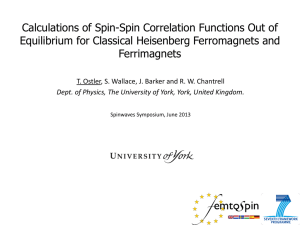
![Photoinduced Magnetization in RbCo[Fe(CN)6]](http://s3.studylib.net/store/data/005886955_1-3379688f2eabadadc881fdb997e719b1-300x300.png)
